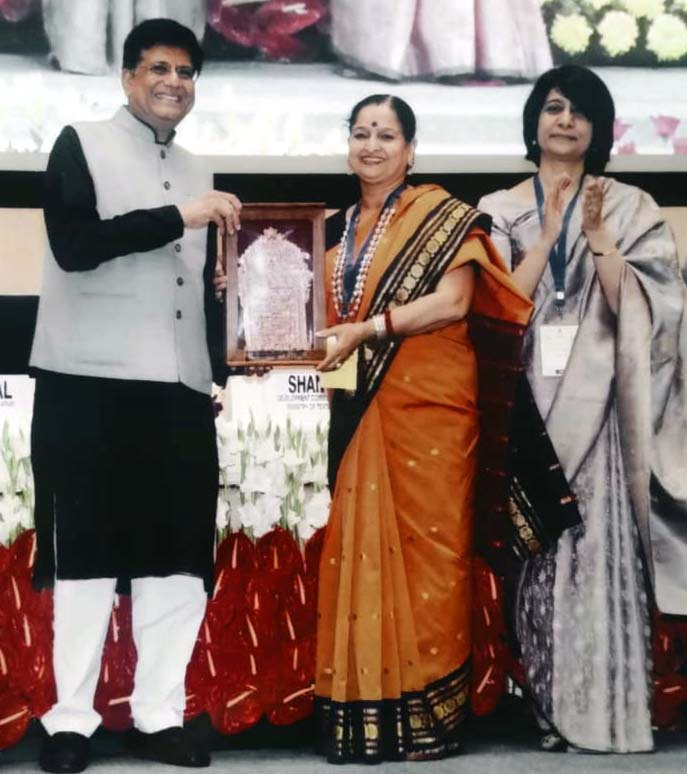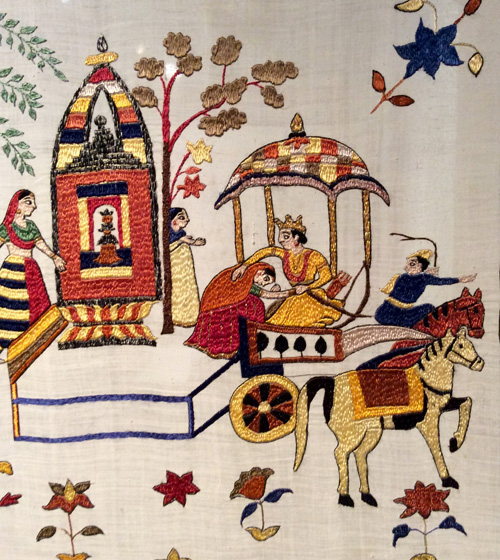Introduction
For many, the unassuming cloth handkerchief is a commonplace object in daily life. Often embellished with monograms or subtle patterns, these hankies serve the simple purpose of wiping hands and faces. However, the Chamba Rumal (where “rumal” translates to handkerchief) defies convention. Far from ordinary, it’s a unique and treasured artefact, far too precious to be employed for wiping one’s face.
What is the Chamba Rumal and Where it Comes From
This rumal gets made in Chamba, nestled at the base of the majestic Himalayas, Chamba is a small town resting alongside the River Ravi, also known as the River Irawati. Evolving with time, it has flourished into a relatively affluent community. While upholding age-old customs and cultural values, the town embraces contemporary advancements in infrastructure, transportation, and a forward-looking perspective. The local dynamic involves both men and women collaboratively engaging in tasks and roles, striving collectively to safeguard their artistic and cultural legacy. Another known art school that flourished in the region was the Pahari School of Painting. Dating back to the 17th century, the Pahari school of art garnered regal support since its inception in the region. While miniature Pahari paintings are its hallmark, the term encompasses a range of expressions, spanning from murals to paintings. The exquisite needlework found on the Chamba Rumals draws inspiration from this artistic movement, effectively fusing the finesse of miniature art with the craftsmanship of embroidery.
Brief History of Chamba Rumal
Interestingly, the earliest instance of this embroidery can be traced to Punjab. In the 16th century, Bebe Nanki, the sister of the Sikh spiritual leader Guru Nanak, is said to have crafted one. This particular piece was safeguarded at the Hoshiarpur shrine in the state. Another Chamba Rumal journeyed to Britain in 1883, gifted by Raja Gopal Singh. This intricately embroidered handkerchief depicted a scene from the Mahabharata and eventually found its place in London’s Victoria & Albert Museum.Chamba Rumals are commonly crafted in square or rectangular pieces of fabric, available in diverse sizes. The foundational artwork, known for its detailed lines, is traditionally rendered by specialists in miniature art. After the artistry is finalised, the meticulous embroidery, often carried out by women, is skillfully applied onto the fabric.During the 17th century, Chamba Rumal embroidery was skillfully executed by the queens and noble women of Chamba. These intricate works adorned wedding dowries, significant presents, and ceremonial coverings.
Design Language of Chamba Rumal
Gradually, the tradition transcended palace confines and extended to local craft communities. These Rumals became an essential aspect of weddings, exchanged between the families of the bride and groom as tokens of goodwill.In his book “Chamba Himalaya: Amazing Land, Unique Culture,” KR Bharti underscores the meticulous process of Chamba Rumal embroidery. Using naturally dyed silk floss on materials like mal-mal or khaddar, the designs feature a distinctive double-sided technique. Bharti explains, “The imagery on both sides of the fabric is nearly identical… The design is outlined with delicate charcoal or brushwork. The embroidery employs a range of colors, employing a double satin stitch, alternating forwards and backwards. Both sides of the cloth are embroidered simultaneously, ensuring that the design is filled on both sides, rendering a balanced and congruent appearance. This technique is aptly termed ‘dorukha’ (two-faced).”
Revival and Resurgence of Chamba Rumal
Flourishing until the early 20th century, the art experienced a decline in support from royal circles, causing its gradual demise in the latter half of the same century. Despite the recognition garnered by local craftspeople such as National Award honorees Maheshi Devi, Lalita Vakil, and Chhimbi Devi for their embroidery prowess, the Chamba Rumal lost its prominence over time. This decline allowed space for the emergence of inexpensive and counterfeit imitations, further erasing its genuine legacy from public awareness. In the past few decades, the combined endeavours of NGOs and governmental organisations have refocused attention on the relatively obscure art form. Kamaladevi Chattopadhyay, freedom fighter and crafts revivalist, was among the earliest who took up the onus of keeping the art form alive in the years post independence. One such institution is Delhi Crafts Council, it has undertaken a series of efforts to revive and popularize this art form.

DCC, in its pursuit of preserving and propagating this art form, founded Charu, a training center geared towards empowering artisans with the skills and resources necessary for a sustainable livelihood. This commitment was exemplified in its recent exhibition and sale of Chamba Rumal embroidery, held at Delhi’s India Habitat Centre. The exhibition presented a diverse collection of these meticulously crafted “rumals,” while also paying tribute to the artisans and craftspeople dedicated to preserving this singular art form. Additionally, the Council provided guided tours of the exhibition, enabling passionate art enthusiasts to gain a comprehensive insight into this exceptional artistry. An exhaustive examination of historical rumals held in numerous museums both within the country and abroad was conducted. From this, a central compilation of handpicked rumals was meticulously recreated by Chamba’s artisans and subsequently showcased in various cities across India. They have subsequently organised multiple art exhibitions using the Chamba embroidery repertoire and utilising the craft in newer ways, reflecting upon its past with new dimensions and ideas.

Over the years, the Chamba Rumal artists have received their due recognition, such as Dinesh Kumari, hailing from ward number 7 within the town, secured the national accolade for her commendable efforts in championing the art of Chamba ‘rumal’. In a conversation with The Tribune, Kumari shared, “I began crafting Chamba ‘rumal’ when I was merely 10 years old, with my elder sister guiding me.” Elaborating on the artwork, she highlighted its unique attribute: the identical pattern visible on both sides of the fabric. “Chamba ‘rumals’ are truly exquisite embroidered creations, portraying narratives from epics like Geet Govind, Bhagavata Puran, or even simpler depictions of Radha-Krishna and Shiva-Parvati,” Kumari further explained.
Changing times….
In 2007 with the granting of the Geographical Indication (GI) patent to Chamba Rumal by the Geographical Indications Registry. This step not only countered the trade of counterfeit goods but also reinstated the art form’s prominence.During the 2017 Republic Day parade, Himachal Pradesh presented a tableau, marking the first appearance in four years. The tableau showcased an impressive rendition of the Chamba Rumal, conceived by Prof. Him Chatterjee, who leads the visual art and painting department at Himachal Pradesh University.Today, the foremost challenge faced by Chamba Rumal embroiderers revolves around preserving the craft in the modern era. Although their efforts towards revival are gradual, the dedicated artisans and revivalists of the region are ensuring the tradition of this exquisite needlework, often referred to as the “needle wonder,” perseveres and gets passed down to future generations.


Contributor





